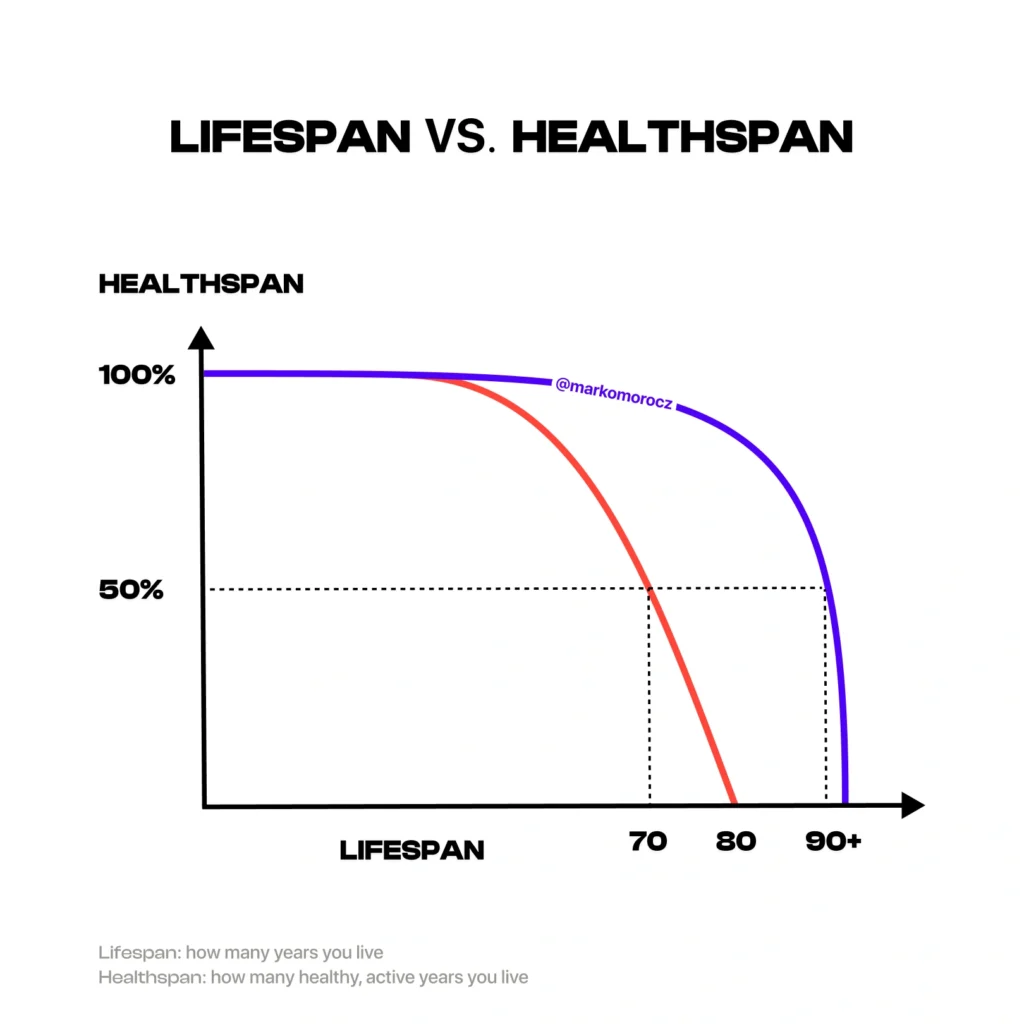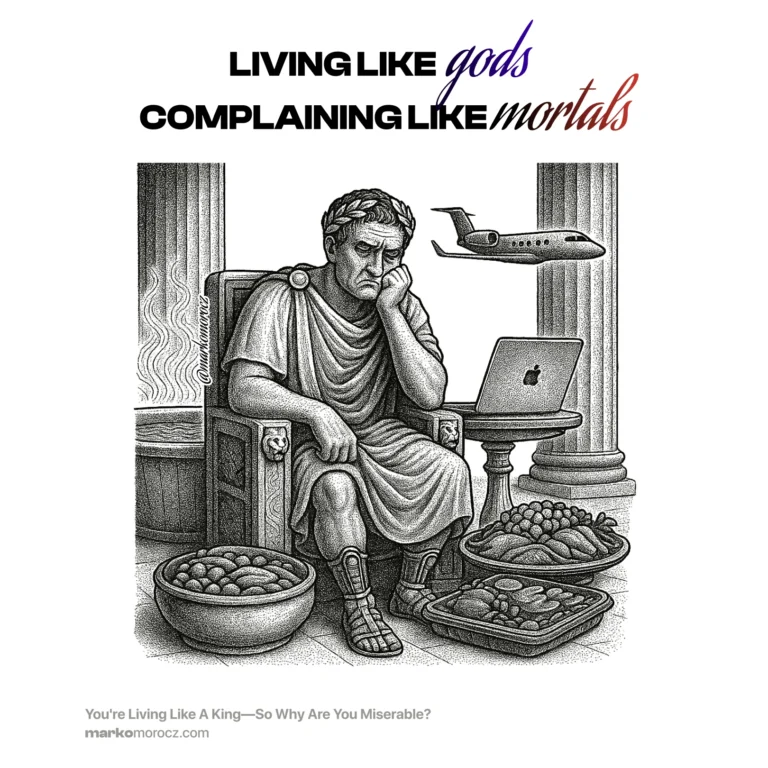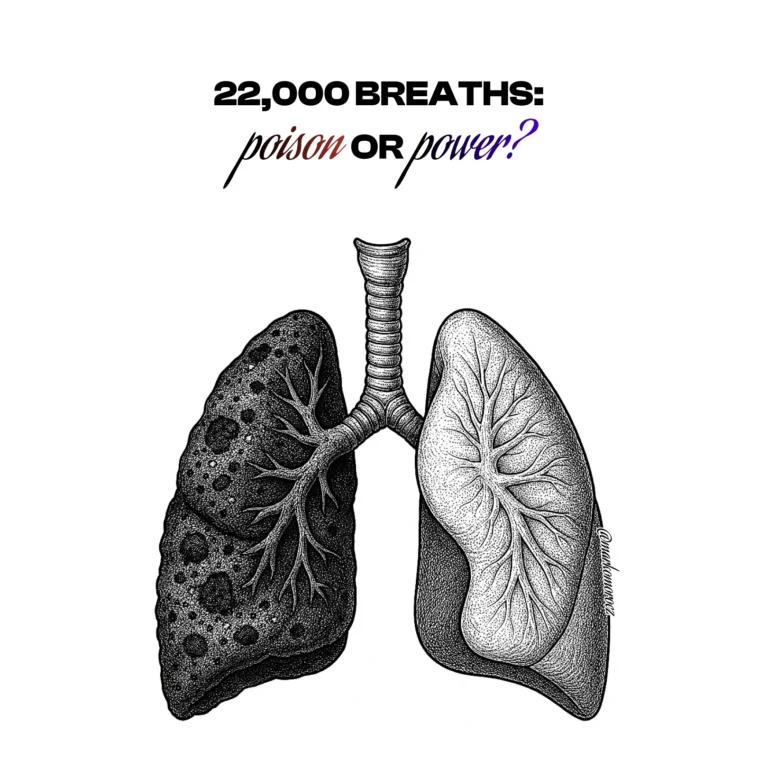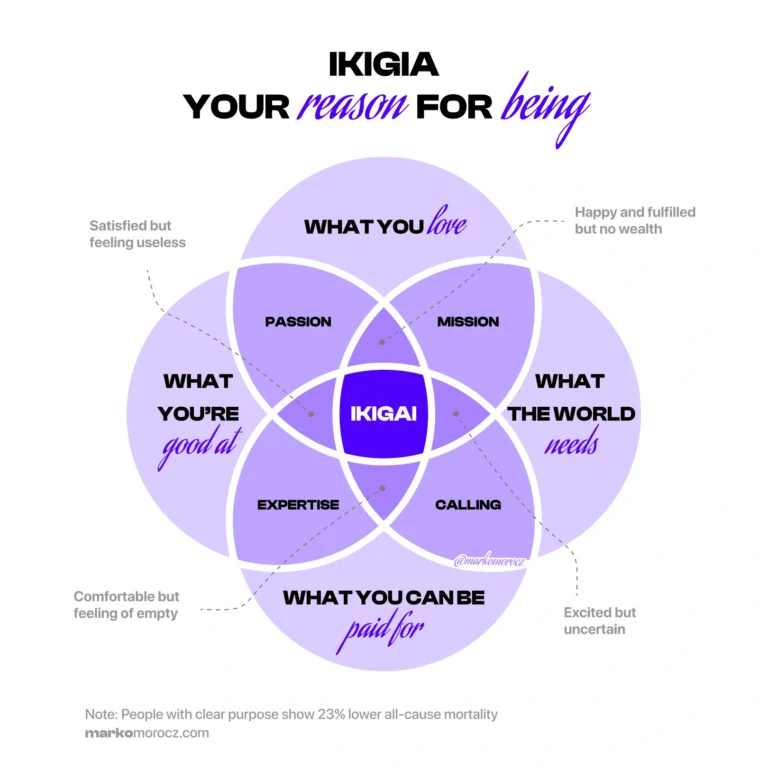What Is Longevity? Fighting Death’s 4 Horsemen And Your Unmet Potential
You’re in the arena. Nobody asked whether you want to be here. But here you are. A gladiator in the largest Colosseum: your life.
Your enemies? Death and your unused potential. Because living as a ghost of who you could be is living dead. Not caring about your health—the engine of your potential and your years? Tragic.

Your weapon? Longevity.
Long life, yes, but it’s split into two dimensions:
- Lifespan: how long you’re here
- Healthspan: how good those years are
Know them. Track them. Work on them. Because what you measure gets better.
Here’s a chart for the visual gladiatrices and gladiators:

To max out your health and your potential every day, you must fuel both.
Lifespan: Facing the Grim Reapers
Death comes in a thousand flavors. But the heavy hitters? The Four Horsemen of chronic disease, plus accidents. They account for 80% of deaths among non-smokers1.
We can’t dodge every bullet, but those four riders? They’re predictable. They’re beatable. That’s where the smart fight is.
Meet The Four Horsemen of Chronic Disease
They’re watching you from day one. Circling shadows in your arena. They can’t wait to get you.
Fair? Decide yourself.
But you can’t fight something you don’t know. Know their strengths, weaknesses, and hideouts (e.g., in your oily doughnuts, or consistent bad sleep). Knowing their game is half the battle.
1. Atherosclerotic Disease: The Clogged Pipes (e.g., heart attack, stroke)
Your blood rivers turning into sludge-filled drains. Blockage to the heart? Lights out. Blockage to the brain? Your mind goes dark.
Fight back with your lungs and your legs. Studies show regular aerobic exercise can reduce cardiovascular mortality by up to 35%2.
Zone 2 cardio—that steady, conversational pace—builds the aerobic engine that keeps your blood flowing clean and your heart pumping strong. Research demonstrates that moderate-intensity exercise improves endothelial function by 23% and reduces arterial stiffness by 18%3.
But exercise is just one weapon. Eat single-ingredient, unprocessed foods—the Mediterranean pattern shows 31% cardiovascular disease risk reduction through olive oil, fish, vegetables, and nuts4. Quality sleep reduces heart attack risk by 22%5. And chronic stress? It doubles your risk—master stress management to cut this Horseman down6.
2. Cancer: The Cell Rebellion
Your own cells turning traitors, multiplying like a plague. They choke the good cells. Research indicates that up to 40% of cancers are preventable through lifestyle modifications7.
Starve them, poison them, and hunt them down. Regular physical activity reduces cancer risk by 13-27% across multiple cancer types8. But deploy your full arsenal: maintain healthy body composition (obesity increases cancer risk by 40-50% for multiple types)9, eliminate smoking and limit alcohol (together responsible for 30% of cancer deaths)10, and flood your system with anti-inflammatory foods rich in polyphenols and fiber11.
3. Neurodegenerative Disease: The Mind Thief (e.g., Alzheimer’s)
Your memories, your thoughts, dissolving like smoke. Your brain, once a shiny fortress, crumbling.
Guard your mind fiercely with sleep and relentless mental sparring. Recent studies suggest quality sleep can clear amyloid beta, a protein linked to Alzheimer’s12.
But don’t stop there—aerobic exercise increases brain-derived neurotrophic factor (BDNF) by 32%, literally growing new brain cells and protecting existing ones13. Zone 2 cardio pumps oxygen-rich blood to your brain, feeding the neurons that store your memories.
Social connection is your secret weapon—strong relationships reduce dementia risk by 50%14. Learning new skills builds cognitive reserve. Single-ingredient foods with omega-3s feed your brain the fats it craves15. And that chronic stress? It shrinks your hippocampus—the memory center. Tame it or lose your mind.
4. Foundational Diseases: The Metabolic Meltdown (e.g., diabetes, fatty liver)
Your body’s fuel system going haywire, turning sweet into poison.
Fix the engine with iron and clean fuel. Evidence shows strength training can improve insulin sensitivity by up to 48%16. But combine it with Zone 2 cardio, and you’re teaching your body metabolic flexibility—the ability to efficiently burn both fat and glucose. Studies show regular Zone 2 training improves insulin sensitivity by up to 85% and reduces visceral fat by 31%17.
Time-restricted eating amplifies these effects—limiting eating to 10-12 hours improves metabolic markers by 22%18. Quality sleep regulates hormones that control hunger and metabolism19. Even cold exposure can boost metabolic health by activating brown fat and improving glucose uptake20.
It’s not sad. It’s power. It’s freedom.
Why? Knowing the enemy lets you build your defenses. Every sweat drop, every healthy meal? That’s armor plating. Every hard workout? That’s a sword strike against the Horsemen.
I tested my own genetics. Scary? Hell yes. But knowing what lurks in your shadows lets you prepare the battlefield. Being in control made me happy. Now, even the pain of training is a reminder I’m slaughtering Horsemen and farming bonus points for my longevity armor.
Healthspan: Living Like You Mean It
Healthspan isn’t about shuffling through extra years. It’s about those years being yours. Having the energy to show up for your loved ones at the end of the day. Lifting your kids without your back screaming. Sculpting your obsessions without brain fog.
Three thieves come for your potential and quality life:
- Cognitive Decline: Your mind gets slow, cloudy. Your memories fade. It’s you, getting lost in the void. Research shows that challenging mental activities can build cognitive reserve, delaying symptom onset by up to 5 years21. You wouldn’t fight with a rusty sword. Don’t let it happen to your brain.
- Physical Deterioration: Your body turns on you. Pain steals your movement, weakness chains you down. Studies demonstrate that adults who maintain muscle mass have 19% lower all-cause mortality rates22. Build resilience today. Sculpt your body. Make love.23
- Emotional Erosion: Your fire dims. Your purpose fades. Your connections wither. Research indicates strong social connections can reduce mortality risk by up to 50%14. Tend to your soul. Cultivate joy and fierce bonds.
The decline happens in waves. With time the waves get bigger and eat up your island. Different people have different thresholds. Some never experience high mental and physical performance. Their days are drowned in food coma, brain fog, and weakness. They think pain is normal. They think it comes with age.
But aging doesn’t have to be a slow surrender. You can add years, but you sure as hell can fight for those years to be meaningful and vibrant.
Your Battle Plan:
Mind: Solve problems, create things, learn from mistakes, and sleep like a baby. A meta-analysis found 7-8 hours of quality sleep improves cognitive function and lowers risk of cognitive decline25. Bonus if you meditate, harness the power of stress, and hydrate with minerals.
Body: Eat single-ingredient foods, not too much. Lift weights, run far and stretch. Research shows combining resistance and aerobic training provides complementary benefits unachievable by either alone26. Sculpt your flesh every day.
Soul: Find your fire, find your ikigai—your reason for being—obsess about your purpose, connect and love deeply. People with a strong sense of purpose show 23% reduced all-cause mortality27.
Your years are finite. But your quality of life isn’t predetermined. Use your health to max out every moment, your obsession and legacy.
Fight every day. Finish this arena a champion.
Notes
Here’s what declines with age if you don’t train: Stability, flexibility, mobility, strength, muscle mass, bone density, aerobic efficiency, anaerobic output, freedom from pain, and sexual function.
References
- GBD 2019 Diseases and Injuries Collaborators. Global burden of 369 diseases and injuries in 204 countries and territories, 1990-2019: a systematic analysis for the Global Burden of Disease Study 2019. Lancet. 2020;396(10258):1204-1222. ↩︎
- Lear SA, Hu W, Rangarajan S, et al. The effect of physical activity on mortality and cardiovascular disease in 130,000 people from 17 high-income, middle-income, and low-income countries: the PURE study. Lancet. 2017;390(10113):2643-2654. ↩︎
- Green DJ, et al. Effect of exercise training on endothelium-derived nitric oxide function in humans. Journal of Physiology. 2004;561(1):1-25. ↩︎
- Estruch R, et al. Primary prevention of cardiovascular disease with a Mediterranean diet supplemented with extra-virgin olive oil or nuts. New England Journal of Medicine. 2018;378(25):e34. ↩︎
- Wang C, et al. Association of estimated sleep duration and naps with mortality and cardiovascular events: a study of 116,632 people from 21 countries. European Heart Journal. 2019;40(20):1620-1629. ↩︎
- Kivimäki M, et al. Work stress as a risk factor for cardiovascular disease. Current Cardiology Reports. 2018;20(11):123. ↩︎
- Islami F, Goding Sauer A, Miller KD, et al. Proportion and number of cancer cases and deaths attributable to potentially modifiable risk factors in the United States. CA Cancer J Clin. 2018;68(1):31-54. ↩︎
- Moore SC, et al. Association of leisure-time physical activity with risk of 26 types of cancer in 1.44 million adults. JAMA Internal Medicine. 2016;176(6):816-825. ↩︎
- Lauby-Secretan B, et al. Body fatness and cancer—viewpoint of the IARC Working Group. New England Journal of Medicine. 2016;375(8):794-798. ↩︎
- GBD 2019 Risk Factors Collaborators. Global burden of 87 risk factors in 204 countries and territories, 1990–2019: a systematic analysis for the Global Burden of Disease Study 2019. Lancet. 2020;396(10258):1223-1249. ↩︎
- Aune D, et al. Dietary fibre, whole grains, and risk of colorectal cancer: systematic review and dose-response meta-analysis of prospective studies. BMJ. 2011;343:d6617. ↩︎
- Shokri-Kojori E, Wang GJ, Wiers CE, et al. β-Amyloid accumulation in the human brain after one night of sleep deprivation. Proc Natl Acad Sci U S A. 2018;115(17):4483-4488. ↩︎
- Voss MW, et al. The influence of aerobic fitness on cerebral white matter integrity and cognitive function in older adults. Human Brain Mapping. 2013;34(11):2972-2985. ↩︎
- Kuiper JS, et al. Social relationships and risk of dementia: A systematic review and meta-analysis of longitudinal cohort studies. Ageing Research Reviews. 2015;22:39-57. ↩︎
- Morris MC, et al. MIND diet associated with reduced incidence of Alzheimer’s disease. Alzheimer’s & Dementia. 2015;11(9):1007-1014. ↩︎
- Ishiguro H, Kodama S, Horikawa C, et al. In Search of the Ideal Resistance Training Program to Improve Glycemic Control and its Indication for Patients with Type 2 Diabetes Mellitus: A Systematic Review and Meta-Analysis. Sports Med. 2016;46(1):67-77. ↩︎
- Malin SK, et al. Independent and combined effects of exercise training and metformin on insulin sensitivity in individuals with prediabetes. Diabetes Care. 2013;36(11):3373-3380. ↩︎
- Wilkinson MJ, et al. Ten-Hour Time-Restricted Eating Reduces Weight, Blood Pressure, and Atherogenic Lipids in Patients with Metabolic Syndrome. Cell Metabolism. 2020;31(1):92-104. ↩︎
- Spiegel K, et al. Brief communication: Sleep curtailment in healthy young men is associated with decreased leptin levels, elevated ghrelin levels, and increased hunger and appetite. Annals of Internal Medicine. 2004;141(11):846-850. ↩︎
- Cypess AM, et al. Activation of human brown adipose tissue by a β3-adrenergic receptor agonist. Cell Metabolism. 2015;21(1):33-38. ↩︎
- Stern Y, Arenaza-Urquijo EM, Bartrés-Faz D, et al. Whitepaper: Defining and investigating cognitive reserve, brain reserve, and brain maintenance. Alzheimers Dement. 2020;16(9):1305-1311. ↩︎
- Abramowitz MK, Hall CB, Amodu A, Sharma D, Androga L, Hawkins M. Muscle mass, BMI, and mortality among adults in the United States: A population-based cohort study. PLoS One. 2018;13(4) ↩︎
- Holt-Lunstad J, Smith TB, Layton JB. Social relationships and mortality risk: a meta-analytic review. PLoS Med. 2010;7(7) ↩︎
- Kuiper JS, et al. Social relationships and risk of dementia: A systematic review and meta-analysis of longitudinal cohort studies. Ageing Research Reviews. 2015;22:39-57. ↩︎
- Xu W, Tan CC, Zou JJ, Cao XP, Tan L. Sleep problems and risk of all-cause cognitive decline or dementia: an updated systematic review and meta-analysis. J Neurol Neurosurg Psychiatry. 2020;91(3):236-244. ↩︎
- Schroeder EC, Franke WD, Sharp RL, Lee DC. Comparative effectiveness of aerobic, resistance, and combined training on cardiovascular disease risk factors: A randomized controlled trial. PLoS One. 2019;14(1) ↩︎
- Cohen R, Bavishi C, Rozanski A. Purpose in Life and Its Relationship to All-Cause Mortality and Cardiovascular Events: A Meta-Analysis. Psychosom Med. 2016;78(2):122-133. ↩︎





